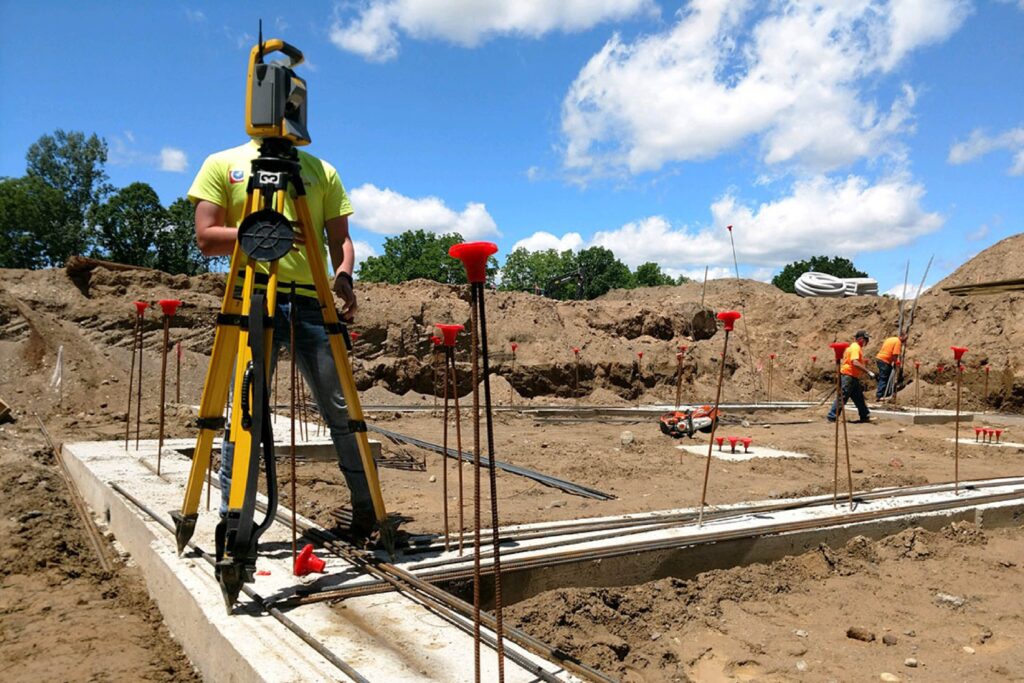
Construction Staking: More Than Meets the Eye
Site development is a complex process that involves planners, engineers, architects, and a slew of construction trades to expertly guide a project through the planning, design, and construction phases.
While the emphasis tends to focus on upstream activities, from planning and zoning assistance to site engineering and architectural design, construction management can make or break a project, especially when it comes to construction staking and layout services.
So, what is construction staking?
Construction staking – also referred to as construction layout – is the process of putting stakes in the ground to show contractors and builders where proposed features – like paving, buildings, and utilities – should be built per the construction documents.
While this definition seems straightforward, converting proposed site plans into plottable digital computations in the real world is a pivotal step in the construction process and a critical quality assurance practice.
Before field survey crews step foot onto a site, the office team performs a rigorous QA/QC process when computing and translating the development plan onto the site. This upstream analysis helps identify errors and conflicts across project plans – structural, architectural, and civil – in advance of fieldwork to keep a project on time and budget while avoiding costly resolution downtime and back charges from error removal and replacement.
An Overview of MCA’s QA/QC Analysis:
• Confirm site boundary and features
• Establish and maintain site control network
• Conduct structural/architectural/civil plan overlay analysis
• Review daily field notes and confirm calculations from grades and slopes
• Examine proposed site features and placement relative to overall property lines and elevations

Once on site, the field crew establishes a control network – a system of reference points and benchmarks created on a construction site to provide precise spatial reference for surveying and construction activities. This control network is the backbone of the entire project and is used daily to inform quality assurance and control efforts.
The crew then stakes the exact locations to individual trade tolerances where structures, paving, utilities, and other site features will be built. In addition to construction staking, surveyors can also provide quality assurance monitoring – a.k.a. measurement testing – throughout the construction process, ensuring project execution is according to design plans. Early identification of deviations through these monitoring efforts allows for more timely corrections, often with cost-saving benefits.
Throughout the construction staking process, from project initiation to completion, continuous communication with the site superintendent is vital. No project is without challenges, but partnering with a survey team that advises early and often concerning errors and conflicts, possible solutions, and collaborative strategies ensures alignment of expectations and project success.

Why hire professional surveyors for construction staking?
As previously illustrated, construction staking is more than just putting stakes in the ground. A critical QA/QC process, construction staking requires a mastery of skills, accuracy, and experience that can make or break a project’s success.
Although surveying usually accounts for less than one percent of the overall budget, contractors or private property owners often view it as expensive and low value and try to save a few bucks by doing their own staking. While common, many reasons exist to avoid the DIY approach, including blown budgets and timelines, legal disputes, and possible project failure. For example, the cost to address construction errors resulting from non-compliance with setback regulations, or worse, constructing on a neighboring property, could be prohibitively high, potentially leading to project bankruptcy. In essence, using professional surveyors is a form of insurance policy in practice.
In addition, professional survey teams understand the intricate calculations powering their survey equipment and deliver critical thinking and problem-solving skills forged through decades of diverse and unique project experience.
What truly makes professional survey teams invaluable is the expertise in legal and regulatory compliance they bring to every project. Surveys are critical legal documents, so it’s essential to work with a team proficient in requisite documentation that complies with authorized standards. This involves securing permits, certifications, and approvals from authorities and furnishing project owners with certifications after project completion.
Order the Right Survey Type for Your Project
A survey means different things to different people, and many don’t know which type of land survey they need. Learn more about the seven most commonly used surveys.
How do you qualify construction survey teams?
Projects do not magically translate from paper to reality. So, it’s important to opt for an expert survey team that excels at spotting and swiftly resolving conflicts to keep your project on track and within budget.
We’re talking about survey teams comprised of licensed professional surveyors, highly trained or certified technicians, and veteran field crews.
Here are a few questions to consider when qualifying survey teams for your next construction project:
1.) What quality control procedures does your team use?
2.) How has your team identified and resolved errors prior to staking and before involving field trades?
3.) Has communication been responsive and according to the discussed timeline thus far?
Founded as a land surveying company 15 years ago, Metro Consulting Associates (MCA) continues to innovate, grow, and expand its survey capabilities to remain adaptive, nimble, and high-value when it comes to client needs. Our survey teams are reliable partners that deliver unwavering performance backed by 500+ years of survey experience.
Discover the full extent of our survey capabilities and contact our team to elevate your next construction endeavor.

Stay connected!
Subscribe to News + Ideas

